Research Article
Nurses’ Knowledge of Blood Glucose Levels and the Management of Hypoglycaemia and Hyperglycaemia: A Descriptive Study
Nursing Lecturer, School of Health, Charles Darwin University, Darwin, Australia
*Corresponding author: Nasreena Waheed, Nursing Lecturer, School of Health, Charles Darwin University, Darwin, Australia, E-mail: nasreena.waheed@cdu.edu.au
Received: March 8, 2017 Accepted: August 18, 2017 Published: August 24, 2017
Citation: Waheed N. Nurses' Knowledge of Blood Glucose Levels and the Management of Hypoglycaemic and Hyperglycaemia: A Descriptive Study. Madridge J Nurs. 2017; 2(1): 56-62. doi: 10.18689/mjn-1000110
Copyright: © 2017 The Author(s). This work is licensed under a Creative Commons Attribution 4.0 International License, which permits unrestricted use, distribution, and reproduction in any medium, provided the original work is properly cited.
Abstract
Diabetes has been among the leading causes of mortality, morbidity and disability around the world. Literature indicates that patient education is vital for diabetes control and management. However, research has shown that nurses' (who are at the forefront of care) knowledge of diabetes is variable and not sufficient in the researched populations.
This study sought to identify and describe the level of diabetes knowledge and the management of hypoglycaemia and hyperglycaemia among nursing staff of a tertiary teaching hospital in South Australia.
A descriptive study design was used with structured observation to gather data on blood glucose monitoring practice and a survey to obtain information on the level of knowledge of diabetes as data collection methods. A convenience sample of nurses, who were directly involved in the provision of care for diabetic patients was observed during blood glucose monitoring and were given a questionnaire to be completed.
Approval for the study was gained from the hospital's Research Ethics Committee. The observation checklist and the survey questionnaire were scored by hand and entered into SPSS and reviewed for data entry accuracy. Descriptive statistics were used to summarize the data. Non-parametric statistics were used to compare the knowledge scores between the mentioned groups since the data were not normally distributed. Pearson product-moment coefficient was used to describe the strength and direction of correlation between selected variables.
Twenty nurses completed the questionnaire and 32 nurses were observed during their practice. The results of this study showed that the demographic data were not correlated with higher knowledge scores or higher observation scores. However, a statistically significant, positive correlation was found between hospital accreditation for blood glucose monitoring and practices score.
It is recommended that this study be replicated in other units of the hospital to see whether the same results could be achieved.
Keywords: Diabetes mellitus; Hyperglycemia; Hypoglycemia; Insulin; Glucose.
Introduction
Background
Diabetes mellitus is a chronic, systemic disease in which the body produces very little or no insulin, or is unable to use insulin resulting in high levels of glucose in the blood [1]. Insulin is a hormone which is required for glucose to enter the cells where it is broken down to release energy [2]. In addition to the chronic complications of diabetes, it can have a major impact on the physical, psychological, social and economic health of individuals [3]. Diabetes has been labeled as an epidemic [1] worldwide with an estimated 4% of the world's population aged 20 years and above having the disease in 1995 (135 million). This number was expected to rise to 5.4% (300 million) by 2025 [4]. However, this number has risen to 347 million in 2013 [5] and currently there are 422 million adults worldwide who already have diabetes [1], surpassing the previous estimate. The prevalence rate remained at 4% for the Australian population between 2007-08 and 2011-12 [6].
In Australia, diabetes has been among the leading causes of mortality, morbidity and disability, accounting for 5.4% of all deaths in 2010 [7]. It costs the economy at least 6 billion Australian dollars for type 2 diabetes [8] and 570 million for people with type 1 diabetes [9] annually and was declared a National Health Priority by the Federal government in 1997 [3]. People with diabetes are likely to consult health professionals or use hospital services more than twice as frequently as those without diabetes. Data from 2010 indicates that about half of the Australians diagnosed with type 2 diabetes were not achieving adequate glycemic control placing them at a higher risk of developing complications [3]. The impact on the health care system is immense and magnified by the long periods of hospital stay by these patients. Nurses, being the largest group of health care professionals and having the longest contact time with these patients, are well placed to provide care and guidance to them.
Research has shown that patient education is vital for diabetes control and management. Increased patient knowledge of diabetes was found to enhance adherence to treatment regimens thereby controlling blood sugar levels [2]. Quality care can have many positive outcomes for diabetic patients like decreased length of hospital stay, decreased risk of chronic complications and improved quality of life [10]. Therefore, nurses need to be well informed of current knowledge and practices of diabetes.
The research literature indicates a shortfall in the knowledge of diabetes care among nurses. An early study by Etzwiler in 1967 [11] compared diabetes knowledge of student nurses, dieticians and physicians by survey and found that diabetes knowledge was lacking among all the three groups. Scheiderich et al [12] developed a 34-item questionnaire in consultation with the American Diabetes Association, which is now known as the Diabetes Knowledge Test (DKT). They surveyed 137 registered nurses from three hospitals. Participants were found to have a mean score of 74%. The pass rate was set at 70%.
Nugent and Kinsman [13] compared diabetes knowledge levels among medical and surgical nurses. They used a convenience sample of 48 registered nurses who were working in medical and surgical units of a large, regional Australian hospital. The findings showed that both groups had knowledge deficits though medical nurses scored higher (a mean score of 71%) than the surgical nurses (a mean score of 63%). In another study, the researchers assessed the knowledge of diabetes among nursing students and registered nurses in the early stages of practice. It was found that diabetes knowledge was lacking in all three groups with mean scores of 65.3%, 57.4% and 13.1% for registered nurses, nursing students and non-nursing students respectively [14].
In 1989, Drass et al [15] used 3 questionnaires: a demographic questionnaire, the Diabetes Self-Report Test (DSRT) and the Diabetes Basic Knowledge Test (DBKT) which is a 45-item multiple choice questionnaire adapted from the DKT of Scheiderich et al [12]. The mean score on DBKT was 64%; a negative correlation (r = -0.36, p<0.001) was found between nurses' actual and perceived knowledge of diabetes. This study highlighted that nurses not only had a low level of knowledge of diabetes, but they are unaware of their lack of knowledge. In a similar study using a convenience sample of registered nurses from a 155-bed community hospital and a home healthcare agency in the US, El-Deirawi and Zuraikath found that the mean score obtained on the DBKT was 72.2%. Since the DBKT was initially designed to assess patients' knowledge, a mean score of 72.2% for nurses, who have the responsibility of educating patients, raised serious questions of the competency of nurses to care for patients with diabetes. A study conducted in a UK teaching hospital replicating the study of Drass et al [15] had a mean score of 69%. These studies have shown that nurses' knowledge of diabetes is variable and not sufficient in researched populations.
Study aim and objectives
The study aimed to identify the current state of knowledge of diabetes among nursing staff ina metropolitan hospital in South Australia.
The objectives were to identify and describe the current state of knowledge related to:
Methods
Study Design
The study used a cross sectional design involving a checklist to guide structured observation of blood glucose monitoring procedures followed by a structured questionnaire together information on the knowledge level of nurses in relation to blood glucose levels.
The Study Setting
The study was conducted in one service unit of a public, teaching hospital in South Australia providing 848 beds for in-patients and associated outpatient services for acute care [16]. The hospital has an accreditation program for blood glucose monitoring; every nurse who joins the hospital staff must achieve accreditation within 4 weeks of commencing work. After the initial accreditation, yearly accreditation is preferred, though the clinical nurse consultants of the particular wards have the authority to decide on the timing of subsequent accreditations [17]. The hospital relies upon standardized procedural descriptions to promote consistency in practice. This level of standardization is to promote decreased practice variability and improved patient outcomes. Standardization of nursing care enables nurse managers to monitor staff compliance with care standards and track improvements in care processes by validating interventions and determining the effectiveness of nursing care through research and clinical audit [18]. This enhances safety and reduces errors by incorporating the best available evidence for practice. Furthermore, the standardized guidelines can be used as criteria against which practice is measured and in doing so outcomes from research and audit become more meaningful [19]. Similarly without standardization, not only is observation of practice ineffective, but the testing of knowledge against standards (such as the hospital's standards for diabetes management) would be meaningless. However, these benefits rely upon the nurses' practicing in particular environments to have a working knowledge of the institution's policies and practices relevant to diabetes care. The particular service unit where the study was conducted has 32 in-patient beds and 40 nurses work in three shifts.
Sampling
A convenience sample of nurses who were directly involved in the provision of care for diabetic patients were recruited for the study regardless of whether they have undertaken hospital education and accreditation in blood glucose level monitoring, and regardless of their duration of employment at the hospital. Nurse Managers and other nursing staff who were not directly involved with the provision of patient care were excluded. Non nursing staff who provided clinical care, such as students, care aides and agency nursing staff were also excluded as their familiarity with the hospitals' procedures and policies may be lower than hospital employees, and may have skewed the results.
Data collection
Questionnaire development and pilot study
An extensive literature search was carried out to find an appropriate questionnaire for the study. Most studies utilized three questionnaires which were quite lengthy and not appropriate for the objectives of this study. Therefore, a questionnaire was developed by the researcher in consultation with her supervisor and the hospital's diabetes nurses educator as per objectives and variables of the study and based upon the hospital's practice manual. The questionnaire contained 24 items. In questions 1-6, the participants were asked to provide demographic and professional details of them. From question 7 to 24, participants were asked to respond to questions that elicit information on their knowledge of diabetes and the hospital's protocols covering the areas: accreditation for blood glucose monitoring, blood glucose levels in diabetic patients, blood glucose monitoring practices in patients with diabetes, quality control of blood glucose monitoring instrument, hypoglycemia, hyperglycemia, Diabetic Nurse Educator referral and discharge planning. All questions were multiple choices, with the exception of one question which asked to list 4 causes and 4 signs/symptoms of hyperglycemia.
The research tool for observation was a checklist prepared by the researcher as per the hospital's blood glucose monitoring accreditation manual.
The content validity of the questionnaire was addressed by using the hospital's protocols for diabetes management integrating current research evidence. It was reviewed rigorously by a research and higher degree committee of nursing. The questionnaire was amended according to their suggestions. To promote reliability of the instrument, the questionnaire was tested by a pilot study before the actual study. Both the observation tool and the survey questionnaire were pilot tested in a similar unit at the study hospital to identify any problems with the wording and obtain feedback on potential difficulties when answering the questions and filling the form. The participants reported that they found the questionnaire easy to understand and took 10-15 minutes for them to complete. No adjustments were needed on the questionnaire and only minor changes were made to the observation checklist.
Observation
Non-participant observation using an observation checklist was used to collect data about blood glucose monitoring practices. The checklist included nurses' rank and accreditation status as demographic data and had 15 items to be observed which were developed from the hospital's blood glucose monitoring guidelines. These were, explanation of the procedure to patient, hand washing before procedure, checking calibration code and lot number of blood glucose monitoring equipment, removal and insertion of the electrode into the sensor, cleaning of the site (fingertip), checking for ready sign on the glucometer, use of universal precautions, pricking the appropriate site, applying blood correctly on the target area of the sensor, providing a cotton wool ball and instructing to apply pressure to the prick site, disposal of lancing device, electrode removal , disposal of gloves and electrode, documenting results and taking appropriate action. To minimize potential limitations of observations, the observations were done from a distance. The researcher spent sometime in the unit before collecting data to get the participants habituated to her presence. To prevent them knowing the topic of the research and changing their behaviors during blood glucose monitoring, the survey questionnaire was not distributed until 32 episodes of blood glucose monitoring were achieved.
Survey
The 24-item survey questionnaire and a cover letter, which included information to participants explaining the purpose of the study, voluntary nature of participation, and how participants' anonymity will be maintained, were distributed during hand over time. They were asked to complete the questionnaire and put it in a sealed box kept in the nurses' station. The researcher met the nurses individually during morning, afternoon and night shifts and handed over the questionnaire to volunteers. The questionnaire number and to whom it was given to was recorded on a sheet of paper to enable the researcher to trace the questionnaires. Out of the 39 nurses who were working during the data collection period, 31 nurses received the questionnaires out of which 20 (65%) were completed, returned and analyzed.
Ethical considerations
Approval for the study was gained from the hospital Research Ethics Committee. Observations agreed to verbally by the clinicians were considered as consent for observation and completion of the survey questionnaire was taken as consent to participate in the survey.
Data analysis
The observation checklist and the survey questionnaire were scored by hand, entered into SPSS and reviewed for data entry accuracy. Descriptive statistics summarize the data. Non-parametric statistics ANOVA (Kruskal-Wallis Test) and Mann-Whitney U test, nonparametric equivalent of independent samples t-test, were used to compare the knowledge scores between groups since the data were not normally distributed. Pearson product-moment coefficient was used to describe the strength and direction of correlation between selected variables.
Results
Survey Results
Twenty nurses completed the questionnaire (Table 1). The mean age of the participants was 33.05 years with a standard deviation of 7.65. The age ranged from 20 to 46 years. Half of the nurses joined the unit in the last 12 months and 2 nurses (10%) have been working in the unit for the last 1-3 years. Twenty percent of the nurses had 3-5 years and 5-10 years of experience in the unit (Table 2). However, the initial year of registration ranged from less than 1 year to more than 20 years (Figure 1). The level of nursing education of the participants is indicated in Figure 2. The largest proportion of the participants (55%) stated that an undergraduate nursing degree was their highest level of nursing education obtained.


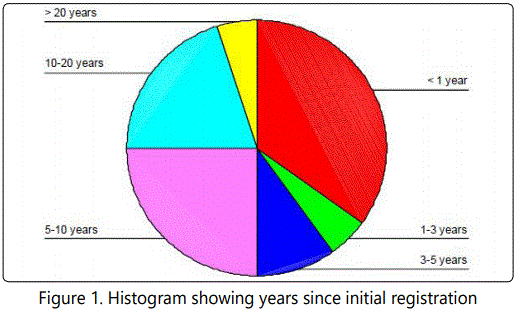
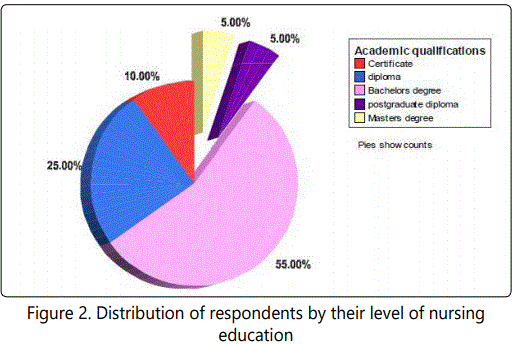
A vast majority (80%) had been accredited for blood glucose monitoring within 4 weeks of joining Royal Adelaide Hospital and 15% indicated that they have never been accredited for blood glucose monitoring (Table 3). The mean knowledge score for all nurses was 40.1 (81.8%) out of a possible 49 points (SD = 4.45). Refer to Figure 3.

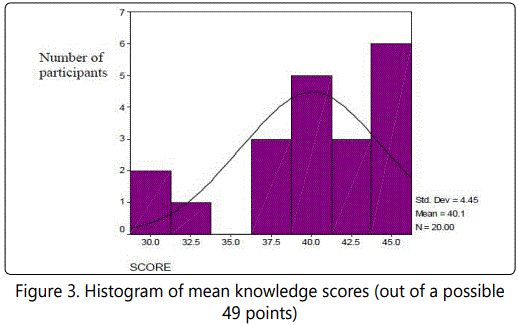
To compare the knowledge scores between the different groups (age groups, length of service in the ward, year of initial registration, academic qualification and accreditation), the non-parametric statistics of Kruskal-Wallis test and MannWhitney U test were used. No statistically significant difference was found between any of the groups.
Observation results
A convenience sample of 32 nurses agreed to the observation. Out of the 32 episodes of blood glucose monitoring observed, 22 (68.8%) were done by registered nurses and 10 (31.3%) by enrolled nurses (Table 4). Among the 32 nurses, 21 (65.6%) nurses were accredited for blood glucose monitoring within 4 weeks of joining the hospital. Of the remaining, 3 were accredited within the last 12 months although they were not accredited within 4 weeks of joining the hospital. Eight (25%) nurses had not been accredited for blood glucose monitoring (Table 5).


The participants were given marks out of a possible maximum of 15. Whenever the nurse performing the procedure missed a point, they lost one mark. The mean score obtained was 14.5 with a standard deviation of 0.84. The following table (Table 6) and histogram (Figure 4) show how the participants scored.
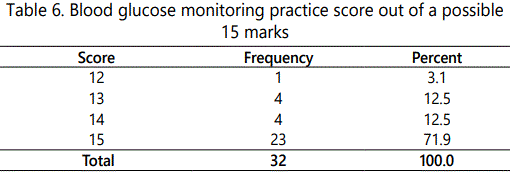
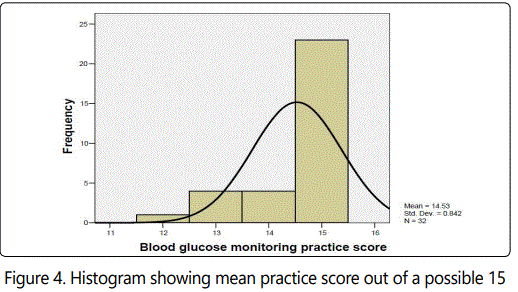
There was no significant difference between knowledge score and nurses' rank while a statistically significant difference was noted between practice score and accreditation.
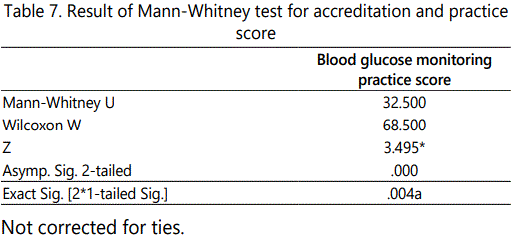
From Table 7, it can be seen that the z value is 3.495 with a significant level of p=.0005. The relationship between accreditation and the practice score obtained was further investigated using Pearson product-moment correlation coefficient. There was a strong positive correlation between the two variables (r=.617, n=32, p<.0005) with high levels of practice score associated with accreditation for blood glucose monitoring. Refer to table 8 below.
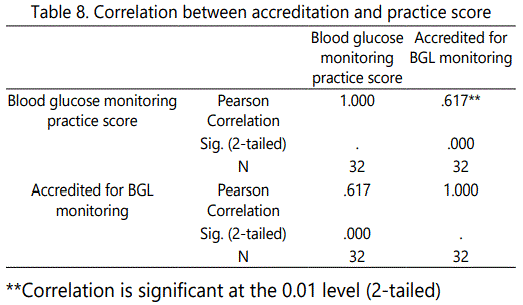
Discussion
Major findings and their implications to Clinical practice
There were certain areas in which participants scored higher. An average of 86% of the respondents identified situations in which blood glucose monitoring should be performed in patients with diabetes; 93.75% had a good knowledge of the typical symptoms of hypoglycemia; and 91.67% of the participants' responses to all the questions on the interventions of hypoglycemia were correct. An average of 93.75% of the respondents gave correct answers to the question on ketones. Another area in which the respondents scored well is the question on quality control. An average of 83% nurses who participated in the survey got all the answers correct to this question. This may be because it is a practical question in which they have to follow the hospital's protocols. The nurses also had good understanding of when to be referred to the Diabetic Nurse Educator (87.5% got the question correct). The highest average percentage scored by the respondents was the question on discharge advice. An average of 96.67% respondents answered all six parts of the question correctly.
There were also certain areas where the participants lacked knowledge. The majority of the nurses (60%) answered the question on normal range of blood glucose in a person without diabetes incorrectly. Since a large portion of the diabetes population is undiagnosed, this knowledge deficit among nurses can lead to serious complications. Only 55% of the nurses knew the acceptable fasting blood glucose values in diabetics and 65% identified the acceptable pre and post meal blood glucose levels in diabetics. This finding is clinically important as diabetic patients fast for a wide range of investigations, including blood tests on a routine basis, thus nurses' need to be aware of the correct parameters for fasting blood glucose levels, or patient health and outcomes are put at risk.
Another very important area that the nurses lacked knowledge was hyperglycemia. When asked to identify four causes and four signs/symptoms of hyperglycemia, only 25% of the respondents were able to do so. Hyperglycemia or high blood glucose levels leads to diabetic ketoacidosis which is the largest single cause of death in patients with diabetes under the age of 40 years [20]. The early recognition and identification of the classic symptoms of hyperglycemia are crucial in the prevention and effective management of this fatal emergency. The finding of 75% of the respondents not being able to identify 4 causes and 4 signs/symptoms of hypoglycemia severely endangers patient safety.
The question on the action to be taken if the result of a quality control test falls outside the “Control Range” was also answered poorly with an average of 63.75% giving the correct response to all the parts of this question. This implies that the hospital's approach of standardizing procedures was not able to be implemented, with the potential consequence being that equipment may not be repaired properly. Therefore, the quality and appropriateness of the care provided using equipment that may have been borrowed, or not repaired may not meet the hospitals standards.
Clearly, these areas are very important areas of diabetes management. The lack of knowledge among the study participants put serious doubts on their ability to provide safe and adequate care to the diabetic patients. Nurses as well as the hospitals they work in have a legal responsibility towards their patients to provide safe and appropriate care. The knowledge deficits identified above are risks to patient care, or patient outcomes. Therefore, these deficits must be addressed to prevent possible legal action against the institution.
This study found that only 71.9% of nurses observed were able to perform blood glucose monitoring correctly. This finding is similar to the results of Lawrence et al.'s study which revealed a deficiency in nurses' performance of blood glucose monitoring [21]. The most unacceptable finding from the observation was that 28.12% of the participants did not follow infection control guidelines putting themselves as well as the rest of the patients in the unit at risk of possible infection. These nurses skipped one or more of the steps from the blood glucose monitoring practice manual and the most commonly missed step was ‘use of universal precautions' (example: gloves). This may be because the nurses were hurried and task-oriented. It could not be said that these nurses did not know infection control practices as guidelines were displayed around the service unit. The nurses skipped steps they may have felt were not important to the accuracy of the task. This highlights the risks to nurses, patients and hospitals using task-orientated practice that is not informed by the appropriate level of knowledge. In fact, it could be taken as a clear indication of a gap between knowledge and practice.
A lack of application of theoretical knowledge to clinical practice was also reported by other researchers [22]. They suggested reviewing the methods used for nurse education so that study days address the specific areas of knowledge deficit and knowledge practice gap. Other researchers have suggested using a link nurse to disseminate new research findings to close the theory practice gap [23]. Clark [24] asserts that beliefs and attitudes could be the major barriers to practice and has to be addressed along with knowledge deficits to change practice behavior. A study conducted by Brake [25] found that increasing self-confidence is the key in bringing about change and education increased the study participants' confidence.
This study also found a large correlation between practice score and accreditation for blood glucose monitoring r = .63, p < .0005 suggesting a strong relationship between these two variables. Nurses who were accredited for blood glucose monitoring made fewer observed errors during the performance of blood glucose monitoring than those who were not accredited. This implies that the hospital's accreditation program is effective in improving blood glucose monitoring practice according to the hospital's standards of care.
A possible solution would be to monitor the accreditation status of individual nurses and conduct accreditation for those who have not achieved accreditation. Furthermore, yearly accreditation should be implemented and monitored as recommended by the hospital, to ensure that all nursing staff who conducts blood glucose measurement has been accredited. Educational programs to increase the knowledge of diabetes are available in this facility, but it's not clear how many staff who works in this particular unit have undertaken the available education. Close collaboration between ward leadership and diabetes educators may have had a significant impact on knowledge levels to inform practice in the study unit.
Conclusion
The results of this study showed that the demographic data were not correlated with higher knowledge scores or higher observation scores. Therefore, the demographic characteristics investigated in this study were not significantly associated with knowledge or practice. The average score obtained from this study was comparatively higher than that of other studies which explored nurses' knowledge of diabetes. This may be because participation in the study was voluntary and this self-selection for participation may have positively skewed the results. The areas of knowledge were found to be highly variable with no clear pattern to correct or incorrect responses across the techniques and safe parameters for blood glucose management. It is recommended that this study be replicated in other nursing units and health care institutions to see whether the same results will be achieved. The questionnaire could be modified to include more aspects of diabetes care, so that a more accurate and clearer picture could be drawn to help in planning education programs for the nurses working in the hospital.
Conflict of Interest Statement
The author declares that there is no conflict of interest.
References